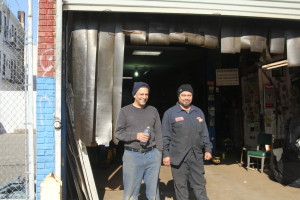People continuously move in, out, and around the city resulting in a fragmented storyline of the past. Finding someone who is able to remember a 1968 event that took place in a specific neighborhood is a challenging venture. I walked down Myrtle Avenue with my camera in-hand ready to capture images of the remaining beams, tracks, and shadows cast by the El on this major thoroughfare. By observing the part of the Myrtle Avenue El that remains from Broadway to Metropolitan Avenue, I hoped to gain insight and find long time residents of the neighborhood.
This sunny and cold Saturday morning, the street was filled with families, shoppers, and young people. Every time the train passed overheard it screeched, distracting everyone, and interrupting most conversations. I recalled the words the city council used to justify demolition of the El on the other side of Brooklyn – decay and dereliction. The buildings and the El are very much decaying. The ground was littered with garbage, but that does not seem to deter businesses, street vendors, or commuters. The El is not to blame for the fact that there are no trashcans for blocks and blocks. Who is to blame?
I turned on to Knickerbocker Avenue, passed a police station, an elementary school, a public housing development, and a fire station. I could still hear the train rumble and screech in the distance. If it is this loud with modern trains, how loud was it with the more antiquated trains that ran in 1968?
As I walked by an auto repair shop, the mechanic, curious about my camera began to ask me a few questions. I explained that I was searching for pieces of the past – and just like that he began to tell me his story. He remembers when the blocks were filled with rowhouses and limestones, as opposed to the public housing buildings that now dominate part of the neighborhood. People just burned their houses to get the insurance money and move to the suburbs, he said. Eddie expressed his anger at the fact these stately houses were long gone.He remembers when this part of Bushwick was a predominantly Italian community, wrestling with very present racial tensions. I continued to ask questions hoping to get more information.
He talked about his experience in the 1977 blackout, and smiled as he described all the new stuff he got that year. I imagined a sixteen year-old Eddie ecstatic about being able to get his hands on that brand new pair of sneakers. Eddie laughed when he explained that people would walk down to Myrtle Avenue, come back with a stolen new couch on a dolly, and just throw their old couch out the window.
We exchanged information, and I caught a great photograph of him and his coworker in front of the shop. Eddie grew up in the neighborhood, then moved away, and recently moved back.
I still have many questions for him, so I setup a time to conduct part two of the interview. Even though Eddie was too young to remember the vanished part of the Myrtle Avenue El, his story
offers context of the changing landscape.
Next time, I will bring my camera and my audio recorder.
By Annel Hernandez
